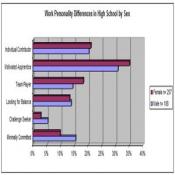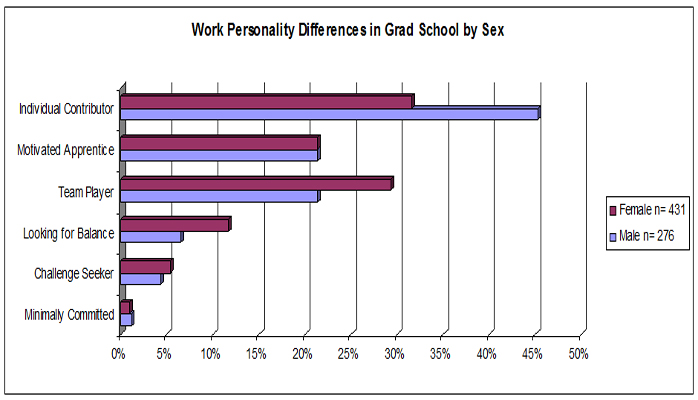
A couple of days ago I posted an analysis of responses to my 'Who Should I Work For?' self-assessment showing that men and women post bacs (grad students and postdocs) differ in the kinds of workplaces they are looking for. By a statistically significant margin, more postbac men than women are looking to be Individual Contributors (making a big impact, changing the world, or making a lot of money). On the other hand, postbac women are significantly more likely to be Team Players (collaborating to solve common problems) or are Looking for Balance (where work is one component of a balanced lifestyle) than the men. I thought it might be interesting to see whether these are persistent trends throughout the educational experience.
Here's how men and women in high school score:
 The Motivated Apprentice category dominates the work personality of both sexes, but interestingly there are no significant differences (statistically speaking) between men and women. Note the huge proportion of men who are 'Minimally Committed' (viewing work as a necessary evil).
The Motivated Apprentice category dominates the work personality of both sexes, but interestingly there are no significant differences (statistically speaking) between men and women. Note the huge proportion of men who are 'Minimally Committed' (viewing work as a necessary evil).
With undergraduates we start to see a difference:
 We see a higher percentage of Individual Contributors and Team Players among both sexes, but with no significant differences. While there appears to be a large difference (7 percentage points) between men and women Motivated Apprentices, it is not statistically significant (p = 0.13). There is a significant difference (p < .01) between men and women Challenge Seekers. Undergrad men, thankfully, are less likely than high school men to be Minimally Committed. Overall, the difference between the male and female work personalities in high school is just barely significant at p < .05.
We see a higher percentage of Individual Contributors and Team Players among both sexes, but with no significant differences. While there appears to be a large difference (7 percentage points) between men and women Motivated Apprentices, it is not statistically significant (p = 0.13). There is a significant difference (p < .01) between men and women Challenge Seekers. Undergrad men, thankfully, are less likely than high school men to be Minimally Committed. Overall, the difference between the male and female work personalities in high school is just barely significant at p < .05.
In graduate school we see the greatest number of differences between men and women:

Almost half of graduate student and postdoc men are identifying as Individual Contributors, which could be traditional Principal Investigator or entrepreneurial roles. The women in this group are far more likely than men to be Team Players or Looking for Balance. The sex differences between the work personalities in this group are the most profound ( p < .005).
What about people out of college or grad school and employed in the workplace?
 Now in our sample, both men and women are identifying strongly as Individual Contributors and Motivated Apprentices, with no differences between the sexes. A significant number of women are identifying as Team Players as compared to men (p <.015), with no differences in the other categories. As with the undergrad population, the differences between men and women in the workforce is just barely significant (p <.05).
Now in our sample, both men and women are identifying strongly as Individual Contributors and Motivated Apprentices, with no differences between the sexes. A significant number of women are identifying as Team Players as compared to men (p <.015), with no differences in the other categories. As with the undergrad population, the differences between men and women in the workforce is just barely significant (p <.05).
What does this all mean? If you ignore our gradstudent/postdoc (postbac) population for a moment, there are barely discernible preferences between men and women as a whole in high school, college and in the workforce. There is a steady increase in the percentage of Individual Contributors and Team Players, at the expense of Motivated Apprentices for both sexes. This makes sense since college-educated employees should be less likely to be attracted by role- and rule-based cultures than high school students (and my sample of the currently employed is probably biased towards those with at least a bachelors degree). Also, note that this is not a longitudinal study, so there are generational and age-related differences which could account for workplace attitudes.
What is striking is the difference between the male postbac population and all the others. For men or women, there is no higher proportion of those who identify with Individual Contributors (45%) than in the postbac group, and it is in this postbac population we see the greatest differences between men and women as a whole. In looking at the data, I saw that a large number (>16%) of the postbacs identified as 'business' majors - presumably MBAs. Could this population of aggressive, CEOs-in-training be skewing the results to Individual Contributors? When I excluded business major postbacs from the analysis, the proportion of male Individual Contributors actually increased (data not shown), so that's not the answer.
I'm continuing to collect data on a daily basis. In a few weeks I'll have another 1000+ respondents across all disciplines. With more data, I can look at the individual undergrad years and separate out the grad student from the postdoc data, as well as looking for differences between disciplines.
Stay tuned.
